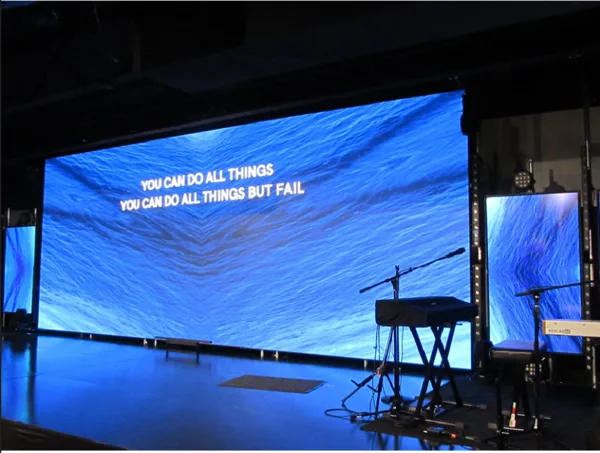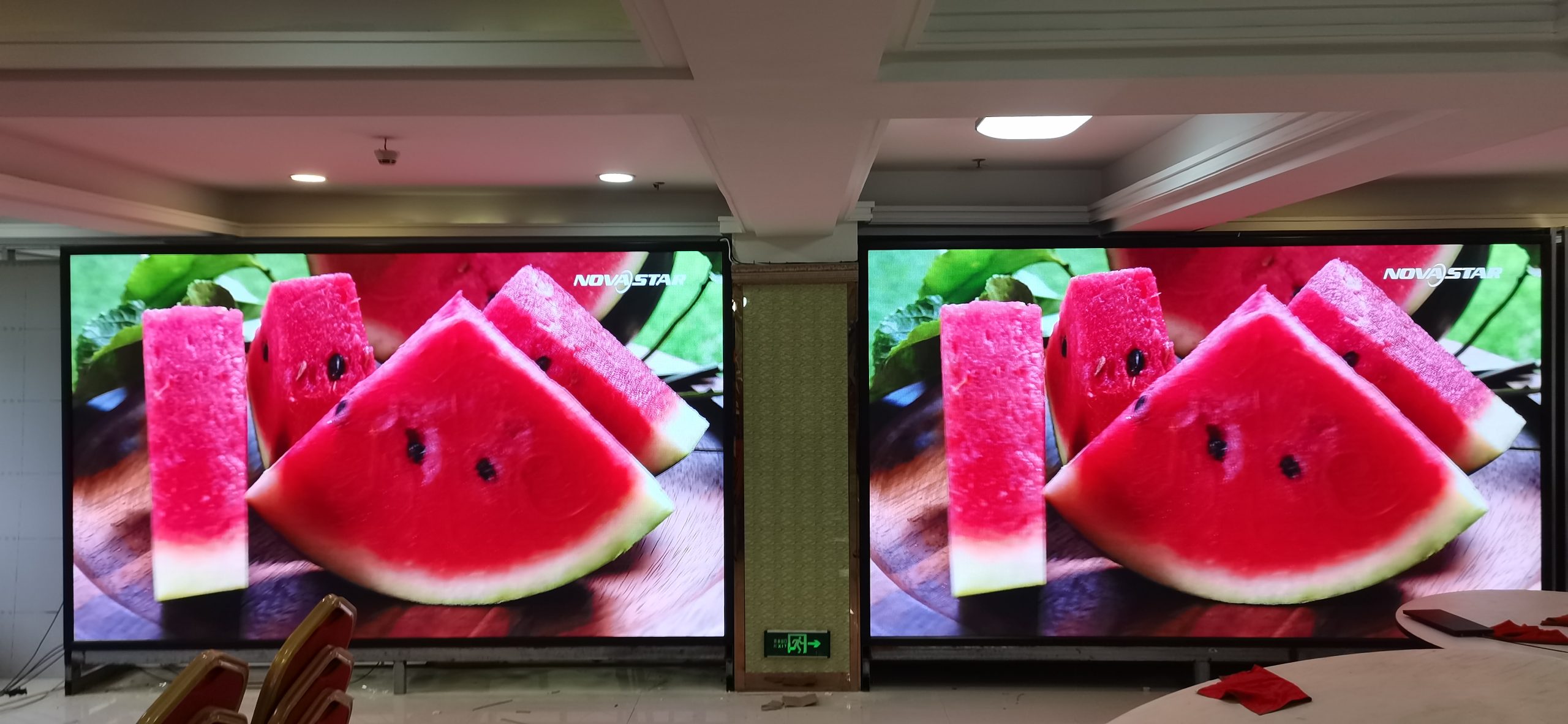
The impact and importance of brightness on LED screens
Brightness is one of the core indicators of LED display, different LED screen brightness determines the application of different scenes, today will be a comprehensive analysis of the impact and importance of brightness for the LED screen band.
What is LED screen brightness
The brightness of the LED screen is the intensity of light emitted by the light emitting diode on the LED module, we often use nits as the unit of brightness. Brightness is also a parameter of different LED spacing products, brightness is too high, it will make people feel blinding, brightness is too low but make people can not see the content of the screen.
LED display brightness is usually in the 800 ~ 5500 nits, it is used to determine the characteristics of the screen of a technology, in different external lighting conditions, the brightness of the LED screen issued by the decision to display the contents of the clear.
Commonly used brightness unit: what is the difference between nits and lumens
Nits and lumens are both units that measure the intensity of light, except that nits are the unit of light used in the past, and now candela or lumens are usually used to measure the intensity of light. This provides greater convenience for us to calculate the brightness of an LED display.
In the past, nits this unit in the expression of the screen brightness, and can not be very accurate expression of the brightness of the high and low, for this reason, the International Conference on Weights and Measures to redefine the new unit of light.
When we want to express the brightness of the LED screen, the use of lumens can make people immediately understand the brightness of the intensity, convenient for us to adjust the overall brightness in a timely manner.

What affects the brightness of the LED screen
The intensity and density of the light emitted
The light intensity of the LED screen can directly affect the brightness of the entire display. For the same size of the LED module, high-quality LED module and low-quality LED module light intensity has a big difference, high-quality LED module can usually send out a stronger brightness.
The pixel density of the LED module also affects the brightness of the LED display. This is because the higher the pixel density, the greater the number of light emitting diodes on the LED module, and the brighter the screen will be.
Power supply voltage
in the LED screen when the power output is not appropriate will also affect the LED screen, because the LED display is made of hundreds or thousands of LED modules spliced together, want each LED module can be normal light, it is necessary to ensure that each LED module can be normal power supply; each LED cabinet has a power supply line, power supply line can make the LED cabinet can be normal power supply, and thus get the LED cabinet Each LED cabinet has a power cable, the power cable can make the LED cabinets can be normal power supply, to get a stable power supply voltage, so that the whole display of LED modules can emit the same brightness.
Low-quality LED
Lower-quality light-emitting diodes may affect the luminous degree of the whole LED screen, because low-quality light-emitting diodes may make its power unstable, easy to dead light phenomenon, resulting in uneven brightness of the light-emitting diodes, can not reach a higher brightness as well.
Heat dissipation function
LED display screen will produce a lot of thermal energy when working, if the heat dissipation system is not perfect, it may lead to the heat can not spread out quickly, so that the LED lamp bead failure, causing the brightness of the LED screen is not uniform.
Different environments
Whether indoors or outdoors, the brightness of the LED screen will be affected in some ways. Indoors, there is no too strong direct sunlight, the brightness can only be adjusted to the appropriate light, if the brightness is too high there will be too much glare or light pollution phenomenon.
But indoors in some of the more humid environments, for example, cave tourist attractions’ signage, in this humid environment LED screen light-emitting diodes and circuits may be corroded phenomenon, affecting the brightness of the entire LED screen. The brightness of the whole LED screen will be affected.
Outdoors, when the sun shines directly on the LED screen, the surface of the display screen will be reflected, so that the audience will not be able to see the content of the LED screen, so you need to raise the brightness of the entire display.
Outdoors, if the waterproofing treatment is not done well, in the rain or snow when the display screen will appear to seepage phenomenon, and the indoor wet phenomenon is consistent with the light-emitting diode circuit corrosion and other phenomena, and at the same time will also cause display side locks and screws appear rust, thus affecting the brightness of the LED screen.

Control system
Usually, six LED modules are connected to a control system, the control system is mainly responsible for regulating the brightness and contrast of the LED modules, if the control system is not set properly, it will lead to the failure of some parameters, so that the brightness of the whole LED screen is not balanced.
Why is the brightness of the LED screen important
Adaptability: For the brightness of the LED screen, it is more adaptable than other displays, because the LED screen can emit light on its own without the need for backlighting technology.
Therefore, the LED screen in a bright light environment, the display will automatically increase the brightness to ensure that the audience can clearly watch the screen, however, in a dim environment the display will reduce the brightness, thus avoiding Too high brightness on the eyes to produce discomfort.
Impact on performance: the brightness of the LED screen will affect other performance indicators, such as the life of the LED screen, contrast, grayscale, etc.; when the LED screen is working, its brightness is closely linked to the life.
Because too much brightness of the LED screen is too high may lead to an increase in the driving current of the light-emitting diode, so that the temperature rises too quickly, the life of the LED screen will be affected. When using the LED screen, we should reasonably adjust the brightness of the screen to reduce power consumption and extend the service life.
For contrast, it is in the brightness part of the LED screen and the darker part of the contrast, can effectively increase the level of the picture, so that the color effect is more realistic.
In the brightness of the LED screen and the grayscale work together, you can make the image of the color is more vivid, the image is smoother and clearer in the bright or dim environment, so that the LED screen image will not appear distortion, overexposure and can not see clearly. Exposure and the phenomenon of not seeing clearly.
Viewing angle: when the brightness of the LED screen is high enough, the viewing angle will also be affected, the higher the brightness of the LED screen, the viewing angle will be gradually expanded, the audience can watch the LED screen in more angles, but also still be able to maintain a good clear image, which is particularly friendly to the outdoor LED display billboard.
Wide range of applications: light-emitting diodes can self-regulate the brightness of the advantages of the LED screen to get a wider range of applications, whether it is low brightness or high brightness, etc., can be in various fields to exude their advantages.
LED screen brightness and application scenarios
Low Brightness LED Display
Low brightness LED display can consume less power cost also helps to save energy, because the brightness is usually used in a soft indoor environment with a color temperature of 2700K-3000K, color temperature is a unit of measurement used to express the light emitted by the light source, in Kelvin (K) to express the unit.
Low brightness LED displays can reduce glare and provide a more comfortable viewing experience for the eyes, as well as reduce eye fatigue.
Low brightness displays are often used in movie theaters, museums and exhibition halls. When used in movie theaters, it can bring great visual comfort, so that the audience can watch the movie content for a long time; when used in the museum of cultural relics, low brightness can relieve the visual fatigue of tourists.
Medium brightness LED display
The brightness is in the middle brightness, brightness in 1500~4000 nits, can be applied in both indoor or can be applied in semi-outdoor environment, in the indoor will not be too high because of the brightness and feel blinding, in the semi-outdoor and will not be too low because of the brightness and can not see clearly; therefore, the application of the medium brightness of the scene is extremely wide.
For example, the station’s LED display screen to update the real-time train information, the hospital’s LED display screen is used to release relevant information to enhance the patient’s sense of identity and trust in the hospital, shopping malls LED billboards can attract the attention of customers to enhance the market’s marketing capabilities.

High brightness LED display
High brightness display is usually suitable for outdoor, because outdoor LED display needs to be exposed to the sunlight for a long time, high brightness can prevent the interference of sunlight and ensure the clarity of the content and color accuracy of LED display.
However, too high brightness will consume a lot of power costs and energy, if you need to ensure that the high brightness of the display can run normally, but also need to have a special heat dissipation function to improve the ability to work and extend the life of the display.
Outdoor display screen has a higher brightness can get a wider viewing angle, the brightness is often used in the concert stage background to provide a high-definition picture effect, equipped with external speakers, so that the audience faster into the concert warm live atmosphere. High brightness LED display can also be used in many venues, such as stadiums, office buildings, outdoor billboards, large-scale activities and so on.

FAQ
How to solve the problem of brightness failure of the LED screen
After installing the LED screen, if the display screen occurs some brightness failure we how to solve the problem, I will give you a list of several points may encounter:
When the LED screen appears black screen, we first check the back of the cabinet to receive the card whether the red light is bright, if it is not bright, we can check the power cord is not appearing in the case of tightness and Wire problems, if the red light is on, the screen is still black screen phenomenon, we have to check the network cable and the receiver card and some other internal control systems.
if you do not find the reason, please contact a professional to carry out door-to-door maintenance in a timely manner.
When the power supply problems lead to uneven brightness, we can check the power supply equipment, such as switching power supply, UPS, etc., to confirm that they are able to carry out normal work, whether the drive voltage is stable and so on.
Summarize
This article explains the importance of brightness in the LED screen, as well as different brightness of the LED display screen of various applications, etc., can make more help for you in the selection of the actual needs of the LED screen.